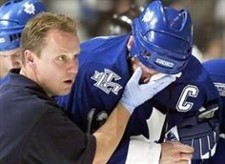Posted:
2/27/2018

Dentists involved with professional sports have an important role.
The incidence of facial trauma in sports is approximately 18% of all sports related injuries. Ice hockey had a particularly high incidence of facial trauma in the early years of the sport. In 1929, the first catastrophic injury, the loss of an eye occurred. After this, the NHL rules did not permit players to play with only one eye. The same rule was applied in the Canadian Amateur Hockey Association (CAHA) when a player from Ontario, named Trushinski, suffered an injury to one eye and later to his other eye, leaving him legally blind. November 1, 1959, Jacques Plante was hit in the face by a shot from New York Rangers player Andy Bathgate. When he returned, he was wearing a crude goalie mask. He refused to return to the goal unless he kept the mask. The Canadiens won 3-1. Plante subsequently designed his own mask and masks for other goalies. Most players, other than goalies, refused to wear them.
In 1978, ice hockey eye injuries gained international prominence. The first international ice hockey doctors' conference of the (IIHF) took place in Prague, Czechoslovakia. After this event, the use of eye protectors for hockey players became common in all hockey playing countries. Then in 1978, came the introduction of the mandatory use of a full facemask in amateur hockey. The consequences of these changes show that blinding injuries are virtually non-existent when approved full facemasks are used. Eye and facial injuries have decreased dramatically over the past 20 years as mandatory facial protection was instituted in collegiate and minor league play.
The problem, however, remains that as soon as they enter the NHL many players remove that layer of protection, making them vulnerable to injury. The risk of eye injuries is particularly concerning as permanent vision issues can lead to career-ending and catastrophic consequences. Sticks, pucks and direct blows from a fist are the common causes of these injuries. Over the course of the past few years, a number of injuries to the face continues to cause players to miss games and have led to the end of the careers of several prominent players, including Chris Pronger.
Despite these injuries, there remains a culture in professional hockey that tolerates players not wearing facial protection. It is an ongoing battle that those of us close to the game have been dealing with since 2007. Additionally, fighting is not only allowed, but is actually a part of the game. No other sport, other than boxing or Mixed Martial Arts, allows the participants to fight to the point of actual injury. While team doctors and front office management continue to fight the battle over mandatory face shields, players who do get injured need to have access to the best possible care available.
The American College of Surgeons' guidelines for optimal care in Level I and II trauma centers, the centers that treat the most serious and complex facial trauma patients, recommend that an oral and maxillofacial surgeon be included as a member of the center's trauma team. Those of us involved in professional sports feel very strongly that all teams should have a dentist and oral and maxillofacial surgeon to cover their team. We are uniquely qualified to provide facial trauma care and, around the country, have treated innumerable injuries. From minor lacerations, avulsive dental injuries to facial fractures, dentists in the NHL have been there to take care of our players. The rewards to those of us doctors treating these world class athletes is something that is hard to explain but it is an extremely energizing part of our practices. When you get involved with any sports team, be it high school, club or professional, you expand your practice on multiple levels. The feeling of belonging to something bigger than your practice or institution provides personal satisfaction as well.
The goal of trauma care for professional athletes is the same as all trauma care. Stabilize the player immediately, assess airway, and confirm c-spine stability, then proceed with definitive care as quickly as possible. The role of rigid fixation is extremely beneficial to provide excellent reduction and stabilization of fractures. Additionally, by limiting or avoiding maxillomandibular fixation, the high nutritional needs of these individuals can be better maintained while they are healing and are released to play again.
In summary, dentists involved with professional sports have an important role in providing the highest level of facial trauma care and it is truly an honor to work with world class athletes, trainers and other medical professionals. We also have a responsibility to continue to push for a safe playing environment, contribute to research, and develop equipment for our athletes.
Dr. Glenn Maron received his D.D.S. from Emory University school of Dentistry in 1986, followed by five years of Oral and Maxillofacial Surgery training at Emory University and affiliated hospitals. Completing his residency in 1991. The following year he completed a Reconstructive Surgery fellowship at Emory.
He is currently the Chief of the Oral and Maxillofacial Surgery section of Children's Healthcare Atlanta, Scottish Rite. Dr. Glenn Maron is also a Diplomate of the American Board of Oral & Maxillofacial Surgery and is a clinical Assistant Professor for the Department of Surgery, Oral and Maxillofacial Surgery section at Emory University, Grady Memorial Hospital and Emory University Hospital Midtown. He is speaking at the Hinman Dental Meeting, March 22-24, 2018 and his course lineup can be found here.



